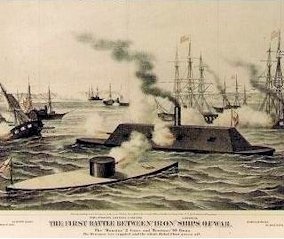
|
Some Common Myths Thought to be True - Myth 126
Myth 126: The "Ironclads" the Monitor and Merrimac Fought Each Other Battle of the Monitor and Merrimack, also called Battle of Hampton Roads, (March 9, 1862), in the American Civil War, naval engagement at Hampton Roads, Virginia, a harbour at the mouth of the James River, notable as history's first duel between ironclad warships and the beginning of a new era of naval warfare. The Northern-built Merrimack, a conventional steam frigate, had been salvaged by the Confederates from the Norfolk navy yard and rechristened the Virginia. With her upper hull cut away and armored with iron, this 263-foot (80.2-meter) masterpiece of improvisation resembled, according to one contemporary source, "a floating barn roof." Commanded by Commodore Franklin Buchanan, and supported by several other Confederate vessels, the Virginia virtually decimated a Union fleet of wooden warships off Newport News, Virginia, on March 8th - destroying the sloop Cumberland and the 50-gun frigate Congress, while the frigate Minnesota ran aground. |
| Battle of Hampton Roads | |
|
The Union ironclad Monitor, under the command of Lieutenant John Worden, arrived the same night. This 172-foot "Yankee Cheese Box on a raft," with its water-level decks and armored revolving gun turret, represented an entirely new concept of naval design. Thus the stage was set for the dramatic naval battle of March 9, with crowds of Union and Confederate supporters watching from the decks of nearby vessels and the shores on either side. Soon after 8:00 am the Virginia opened fire on the Minnesota, and the Monitor appeared. They passed back and forth on opposite courses. Both crews lacked training; firing was ineffective. The Monitor could fire only once in seven or eight minutes but was faster and more maneuverable than her larger opponent. After additional action and reloading, the Monitor's pilothouse was hit, driving iron splinters into Worden's eyes. The ship sheered into shallow water, and the Virginia, concluding that the enemy was disabled, turned again to attack the Minnesota. But her officers reported low ammunition, a leak in the bow, and difficulty in keeping up steam. At about 12:30 pm the Virginia headed for its navy yard; the battle was over. |
|
| ⇦ Back to Myth 125 Return to Myth Choices Page 9 On to Myth 127 ⇨ | |